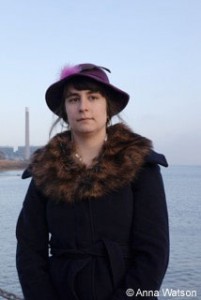 On a chilly, early Sunday morning at the end of November in 2014, I stepped outside my small flat, bid adieu to my husband, hoisted up my long ruffled skirt and started out down the street to catch an early tube to Fenchurch Street Underground Station.
On a chilly, early Sunday morning at the end of November in 2014, I stepped outside my small flat, bid adieu to my husband, hoisted up my long ruffled skirt and started out down the street to catch an early tube to Fenchurch Street Underground Station.
As I settled into a seat in the tube, adjusted my fake fur collar and wide-brimmed felt hat, I glanced around to see if anyone was looking my way. My reason for feeling self-conscious was obvious to anyone who happened to glance at me: I was in an Edwardian costume.
Luckily for me, London is a vast and eclectic city, full of individuals who have seen a lot stranger sights on the London Underground than a young woman dressed like an individual from 1915. How did I end up in this situation? I wondered, about to embark on a whole day’s filming at Tilbury Docks with a group of women I had only met the day before at a costume fitting.
It all started when my parents attended a one day peace conference at the Imperial War Museum last year and met some representatives from the Women’s International League for Peace and Freedom (WILPF). For the last year and half, my mother has been attending a local Quaker group in West London every week, and the peace activists within the group had encouraged everyone to attend the upcoming peace conference held at the museum.
Out of curiosity, my parents went along and it was here they picked up a leaflet advertising an exciting project that needed volunteers for a Heritage Lottery Funded documentary re-enactment of women activists attempting to secure peace in Europe in 1915.
The project, jointly run by WILPF and the Clapham Film Unit, also offered archive training at LSE and oral history training. My mother, knowing my interest in gender studies, oral history and womens’ rights, passed me the flyer. Intrigued by the project, I emailed the Clapham Film Unit and received a friendly response from Charlotte Bill, the creative and driving force behind the Clapham Film Unit. I was both nervous and excited at the idea of meeting like-minded women and I was keen to learn more.
In many ways, I came to the These Dangerous Women Project in an unusual way. I got involved in the project much later than most of the volunteers, I knew very little about the history of WILPF or that the very place where I was employed as an Administrator (London School of Economics) was home to WILPF’s historical archive stretching back to the birth of the organisation in 1915.
I uncovered the project bit by bit and by the time I was meeting the other volunteers in their period costumes outside Fenchurch Street Station, I was beginning to understand that my knowledge of World War I was limited to what I had learned in secondary school.
All school children in the UK learn about World War I. I cannot say what the teaching is like currently, but when I was a student at the age of 12, the Great War was a subject we studied intensively and repeatedly for the next five years of school. I learned all about the causes and outbreak of the war, the battles, the trenches, the support and institutional glorifying of the conflict, the various peace treaties, the League of Nations and the aggressive recruitment of young men to fight and young women to work on the Home Front.
Later, when I was 17 and did A-Levels, I learned about women’s struggle for the vote at the start of the 20th Century and the difference between suffragettes and suffragists. But as I read through the information Charlotte had sent me by email, on a crowded tube full of commuters wearing red poppies for Remembrance Day, I was astounded to discover that none of my school education had included the subject of a British World War I peace movement, especially not one orchestrated by women. I was inspired by the fact that at a time of overwhelming patriotism, when the country geared up for a widespread conflict, several brave women were willing to risk their lives and reputations to pressure international governments to engage in a peace process.
These women and their decision to form a league devoted to the causes of peace and freedom during a time when war was raging across Europe inspired me to help tell their story in any small way that I could.
Clara Manasion Cook